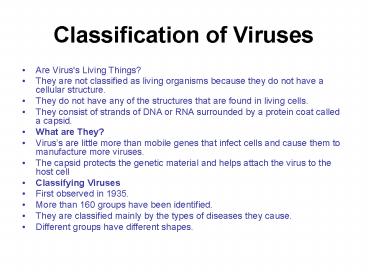Classification of Viruses - PowerPoint PPT Presentation
Title:
Classification of Viruses
Description:
Classification of Viruses Are Virus's Living Things? They are not classified as living organisms because they do not have a cellular structure. – PowerPoint PPT presentation
Number of Views:717
Avg rating:3.0/5.0
Title: Classification of Viruses
1
Classification of Viruses
- Are Virus's Living Things?
- They are not classified as living organisms
because they do not have a cellular structure. - They do not have any of the structures that are
found in living cells. - They consist of strands of DNA or RNA surrounded
by a protein coat called a capsid. - What are They?
- Viruss are little more than mobile genes that
infect cells and cause them to manufacture more
viruses. - The capsid protects the genetic material and
helps attach the virus to the host cell - Classifying Viruses
- First observed in 1935.
- More than 160 groups have been identified.
- They are classified mainly by the types of
diseases they cause. - Different groups have different shapes.
2
- Viral Shapes - Polyhedral
- The Polio Virus responsible for Polio
- T4 Phage that infects E.coli
3
- Viral Shapes - Spherical
- An example of the AIDS virus
4
- Viral Shapes - Cylindrical
- The tobacco mosaic virus
5
Reproduction
- Viruses reproduce by using other organisms.
- They attach to the host cell and inject their DNA
into the cell. - Virus DNA causes the cells metabolism to
replicate more virus DNA - New viruses are replicated and eventually burst
out of the cell. When the cell membrane breaks
open it is often referred to as lyses. - Once it breaks open the host cell dies.
6
Viral Diseases
- There are a number of ways that viruses can
infect cells. - Retroviruses (RNA viruses) use an enzyme (reverse
transcriptase) to cause the host cell to copy the
viral RNA into DNA. - This new DNA instructs the cell to manufacture
more viruses. - Another method is for the viral DNA to be
incorporated into the host DNA. - It remains attached as the host cell goes through
many cell divisions until it eventually completed
its cycle. - While attached to the host cell it is called a
provirus. - Many diseases such as AIDS and cold sores can
remain inactive as proviruses until they are
triggered to complete their cycle. - People test positive for aids virus without
having the symptoms of the disease. - People who are susceptible to cold sores seem to
have them come and go at different times.
7
Using Viruses
- Useful pieces of genes can be copied by using
viruses as a vector. - The genes are combined with the virus DNA and
when they infect cells multiple copies of the
gene are made as the viruses replicate - The multiplied genes can then be harvested.
8
Origin of Viruses
- Viruses are composed of genes so therefore they
developed after cells. - It is believed that they originated as fragments
of genetic material that broke off from the
parent chromosome. - They survived as parasitic organisms on similar
types of cells.
9
General Viral Information
Virus Cell
Structural Parts Protein, Nucleic Acid Core Nucleus, Cytoplasm, organelles, Membranes
Nucleic Acid Either DNA or RNA Both DNA and RNA
Reproduction Requires a Host Cell By Mitosis and Meiosis
Cellular Respiration No Yes
Cystallization Yes No
10
Viruses non-living or alive?
- A virus hijacks its host's cell machinery to
create more virus particles completing the life
cycle. It is the ultimate parasite! - Viruses are somewhere between the living and
non-living. They can reproduce and show
inheritance, but are dependent upon their hosts,
and in many ways can be treated like ordinary
molecules (they can be crystallized!). - Whether or not they are "alive", they are
obligate parasites, and have no form which can
reproduce independent of their host. - Like most parasites they have a specific host
range, sometimes specific to one species (or even
limited cell types of one species) and sometimes
more general.
11
Your Turn
- Read pgs. 122 126
- Page 126 Questions 1,2,3,5































